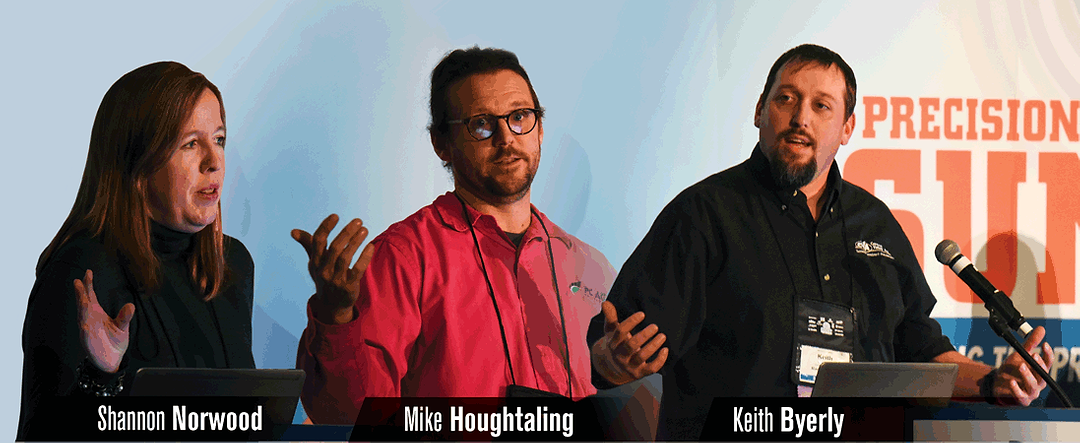The following article is based on Shannon Norwood, Mike Houghtaling and Keith Byerly's presentation at the 2018 Precision Farming Dealer Summit. To watch the presentation, click here.
The shifting nature of precision farming demands a foundation for employee commitment, yet the unique structure of any given dealership eliminates the possibility for any universal blueprint. Rarely does the perfect formula come from direct replication or an unhinged maverick move, but the best plans often fall somewhere in between.
To give 2018 Precision Farming Dealer Summit attendees some guidance in their own pursuit of the ideal employee culture, Shannon Norwood (Integrated Solutions manager, Tri-Green Equipment, Mike Houghtaling (president, P&C Ag Solutions) and Keith Byerly (Advanced Cropping Systems manager, Central Valley Ag) shared some experience-based advice and detailed lessons learned tracking employee efficiency, engagement and putting staff in the best positions for long-term success.
While each dealer represented a unique operation in niche, size and region, two overarching themes prevailed throughout their discussion — the need for clearly defined objectives for efficient employees, and the importance of relationship-based strategies for employee engagement.
Clearly Defined Objectives
Key to the operational efficiency for Norwood at Tri-Green Equipment, a John Deere dealership with 11 ag-focused locations in Tennessee and Alabama, is appointing a lead person for different types of tasks. On the equipment side, task delegation includes a lead person for each type of machinery, from planters to sprayers to combines.
In doing so, Norwood says time isn’t wasted finding the right employee to take on a request, adding that the employee can ensure expertise for customers on one niche of machinery (avoiding the unsuccessful ‘jack-of-all-trades’ approach to service).
“I figured if we were going to hire another person for $80,000 to manage a $60,000 leak, why don’t we just try and tighten up the process first?…”
Tri-Green also delegates one lead employee to take charge of inventory, running the company’s JDLink management account. While she still takes the lead on ordering precision parts, assigning a specialist to centralize inventory has since improved the company’s turnover rates and organization of parts.
Norwood says the inventory delegation exemplifies the overall success of task-based management, allowing her to prioritize being a customer consultant.
“By having a lead person, everybody within our group knows who to go to when issues pop up in specific areas,” Norwood says. “Instead of chasing random things, we resolve issues quicker by streamlining our resources.”
Norwood adds that Tri-Green utilizes outside services for tasks that don’t necessarily need to be done by staff, including the transition to centralized billing through designated service writer on all precision business transactions.
“Instead of having to log into our business system and complete the process on every transaction, we just send our service writer an email with the customer name, the charge, and what was done. It’s been pivotal to timesaving and simplifying the entire process.”
‘What If?’ Succession Planning
All companies are equally prone to emergency sick days or unexpected quits, yet not all are equally prepared to adapt. A point of emphasis for Tri-Green Equipment is keeping every employee up to speed on hypothetical duties during staff shortages, especially as it pertains to their department.
Commitment to Your Niche
Key to establishing a relationship-based culture is clearly defining the objective for one’s business, says Keith Byerly, Advanced Cropping Solutions Manager for Central Valley Ag, a 96-location cooperative across Nebraska, Kansas, Iowa and South Dakota. More often than ever, precision specialists find themselves pursuing other avenues to get involved in, yet Byerly warns the obsession with becoming a one-stop expert on everything can severely hamper service and discourage long-time customers.
“It’s ok to be involved in other business segments, but we have to realize it carries the risk of employees being unclear about the direction of your dealership. Any aspects added to your business need to be integrated in such a way that it becomes your core.”
Byerly says the same philosophy can extend to a dealership’s marketing strategy, as the constant rebranding of dealership’s identity can include hitting the reset button on market share and building a solid foundation of customers.
“We see companies that are constantly reinventing themselves with new company logos and slogans every 12 months. Sometimes that’s ok, but when you’re constantly reinventing yourself, you keep fighting for the same ground over and over again.”
Working with a staff of equipment technicians and GIS specialists, Central Valley Ag bases its entire service foundation around field scouting, helping solidify the company message of an agronomy-first culture.
“Our employees feel like they are part of a team that is agronomy led and agronomy focused, so I don’t have to spend all my effort wondering if they are working on the right projects. I know that they understand what’s important to the culture of our company, which then will extend toward genuine connections with customers.”
Day-to-day demands make it understandable to forego hypothetical concerns, but Norwood warns failing to do so can initiate a domino effect of unintended consequences for employees.
“For all of the resources managers have access to, someone else might not know where they are or how to utilize them,” Norwood says. “An example for us would be communicating with the FCC about pay station frequencies. Lapses in execution on those types of issues can lead severe dips in service.”
Step-By-Step Assurance
Houghtaling places a similar emphasis on providing staff with as much clarity for day-to-day objectives as possible. As the head of a single-location, $2.5 million revenue dealership in Reese, Mich., little margin for error exists for employee confusion and inefficiency. With that in mind, Houghtaling created a series of “How-To” guides as his business grew, laying the blueprint for how he and other experienced employees handle projects in “excruciating” step-by-step detail.
Guides are on-hand for just about everything in the office, from nitty-gritty technical projects to taking out the trash.
“It’s important for anyone we hire because there’s always a script for how we do business,” Houghtaling says. “It lends consistency to our operation. When we visit any customer, even if it’s an employee’s first time, he knows how I would go about doing something.”
Perhaps Houghtaling’s most successful “How-To” Guide is the one he crafted to manage the inventory shrink in his business. At one point several years ago, P&C averaged roughly 2-3% inventory shrink in a year, equating to roughly $60,000 in lost revenue. Looking for a swift solution to reduce those totals, Houghtaling figured hiring an additional staffer would cancel out any bottom-line progress.
“I figured if we were going to hire another person for $80,000 to manage a $60,000 leak, why don’t we just try and tighten up the process first?” He says. “So instead, we wrote a 25 page, step-by-step procedure on how we manage our inventory.”
Since enacting the guide, P&C’s inventory shrink totals dipped below 1%. The company also avoided the burden of finding and training a new hire to produce a likely inferior result.
“We invested a little bit of time on our business from the inside to produce real dollars we can spend at the end of the year,” Houghtaling says.
Employee Engagement & Retention
Norwood emphasizes strong employee-customer relationships to stimulate employee engagement, a process based on weekly summaries on customer interactions from each precision employee. These reports include not only standard business information, but also any personal nuggets of information the customer may have shared with specialists, including birthdays, newcomers to the family or medical issues. In doing so, Norwood says trust can be garnered from farmers while keeping employees passionate about their work.
“I don’t want to forget in April what a great job an employee did during harvest season…” –Shannon Norwood
The same approach to note-taking is applied to Tri-Green’s annual performance reviews, as Norwood makes it a point to document any notable accomplishments from her precision team as they occur. The approach allows her to give thorough assessments and specific examples, validating her investment into the employee and boosting morale.
“I don’t want to forget in April what a great job an employee did during harvest season,” Norwood says.
Personal development plans are another key component to Norwood’s relationships with staff. By sitting down with each employee and discussing future aspirations, Norwood can gauge the long-term prospects of an employee while also helping them get the direct experience they need for the next chapter in their career.
“One of my staff members in the Integrated Solutions department has a long-term goal to move back to the sales department,” Norwood says. “We know that transition is going to happen at some time, so our role is to help him gain as much information in his current role to make him a better salesman when he does eventually move on.”
Finding the Fit, Fitting the Role
Expressing similar sentiments to Norwood, Houghtaling takes a methodical approach to hiring and retention. His process involves finding the correct personality fit for his dealership’s culture, followed by selecting the correct role for said personality so they can best succeed.
A key resource for Houghtaling is StrengthsFinder personality tests. These tests take employees though a series of personality-based questions, scoring them on a variety of different categories pertaining to situational management and likeliness to take initiative.
Houghtaling notes that these tests are not only used during the hiring process, but periodically throughout an employee’s tenure to assess emerging strengths and possible shortcomings.
“The employees that are emotionally engaged in the business are the ones that ultimately are going to stick around,” Houghtaling says. “Once I find their strengths, I can move them into the right role and leverage them.”
A ‘Family Feel’
Another tactic Houghtaling uses for engagement are weekly “traction” meetings. These meetings, which are no longer than 15 minutes to avoid redundancy, are based around scorecards for each employee. Each scorecard contains 3 or 4 goals specific to a staffer, and includes metrics to see how well each employee performed.
Each employee scorecard implemented by Mike Houghtaling, president of P&C Ag Solutions, contains 3 or 4 goals specific to a staffer which are visible to all, encouraging collaboration among staff to hit their benchmarks. Source: P&C Ag Solutions
The achievement of each goal, which can be anything from 5 successful sales calls in a week to a service-related benchmark, is evaluated on a scale and then averaged over the course of a quarter. Houghtaling notes how the weekly tabulations help solidify goals for each employee, enabling positive collaboration among employees at the same time.
“Everyone in the company can see each other’s metrics on a weekly basis, which has been transformative in helping each other reach our goals,” Houghtaling says.
As an extension of Houghtaling’s efforts for positive morale within the staff, he also initiated a weekly unique goal tradition within his company. These goals are intended to challenge employees do to something out of the norm to the benefit of either their family or coworkers, and are often unrelated to business matters.
“It shouldn’t be something that’s your normal job, but instead have it be taking you wife out on a date, or taking your kids to the movies. Maybe it’s even fueling up everybody else’s pickups and getting them washed,” Houghtaling says. “It’s really moved the needle on engagement and made our business more of a family than anything.”




![[Technology Corner] Discussing AI’s Potential Impact on Service & Support](https://www.precisionfarmingdealer.com/ext/resources/2025/04/11/Discussing-AIs-Potential-Impact-on-Service--Support.png?height=290&t=1744385717&width=400)


